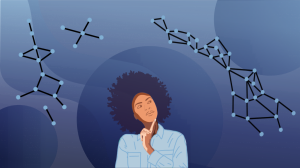by Melissa Pappas

Curiosity has been found to play a role in our learning and emotional well-being, but due to the open-ended nature of how curiosity is actually practiced, measuring it is challenging. Psychological studies have attempted to gauge participants’ curiosity through their engagement in specific activities, such as asking questions, playing trivia games, and gossiping. However, such methods focus on quantifying a person’s curiosity rather than understanding the different ways it can be expressed.
Efforts to better understand what curiosity actually looks like for different people have underappreciated roots in the field of philosophy. Varying styles have been described with loose archetypes, like “hunter” and “busybody” — evocative, but hard to objectively measure when it comes to studying how people collect new information.
A new study led by researchers at the University of Pennsylvania’s School of Engineering and Applied Science, the Annenberg School for Communication, and the Department of Philosophy and Religion at American University, uses Wikipedia browsing as a method for describing curiosity styles. Using a branch of mathematics known as graph theory, their analysis of curiosity opens doors for using it as a tool to improve learning and life satisfaction.
The interdisciplinary study, published in Nature Human Behavior, was undertaken by Danielle Bassett, J. Peter Skirkanich Professor in Penn Engineering’s Departments of Bioengineering and Electrical and Systems Engineering, David Lydon-Staley, then a post-doctoral fellow in her lab, now an assistant professor in the Annenberg School of Communication, two members of Bassett’s Complex Systems Lab, graduate student Dale Zhou and postdoctoral fellow Ann Sizemore Blevins, and Perry Zurn, assistant professor from American University’s Department of Philosophy.
“The reason this paper exists is because of the participation of many people from different fields,” says Lydon-Staley. “Perry has been researching curiosity in novel ways that show the spectrum of curious practice and Dani has been using networks to describe form and function in many different systems. My background in human behavior allowed me to design and conduct a study linking the styles of curiosity to a measurable activity: Wikipedia searches.”
Zurn’s research on how different people express curiosity provided a framework for the study.
Read the full story in Penn Engineering Today.
